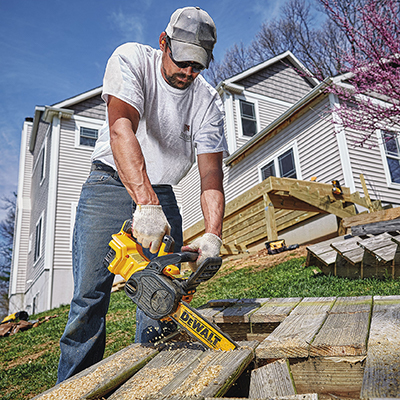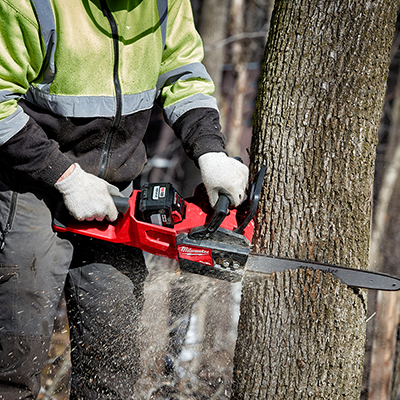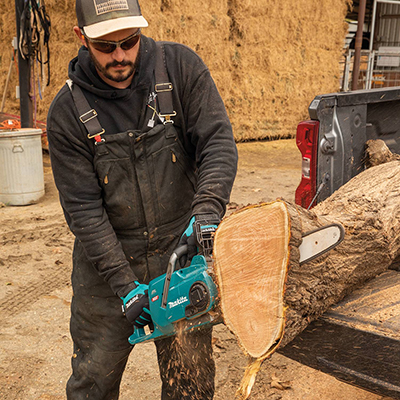How to Sharpen a Chainsaw

Last updated June 16, 2025
Does your chainsaw cut slowly? Is it burning or smoking as it cuts? Did you hit metal while cutting through a tree or tap the concrete while clearing debris? Do you hit the dirt with the chain as the saw is running? If the answer is yes, your chain needs maintenance and knowing how to sharpen a chainsaw is an essential part of that.
A well-sharpened chainsaw is safer to use, more efficient and the chainsaw's engine, sprocket and guide bar will last longer. Read on to learn how to sharpen a chainsaw and use chainsaw files. Plus, get tips on how to sharpen a chainsaw chain and use [electric chainsaw sharpeners] while the chain is still on the saw.
Difficulty:
Beginner
Duration:
Under 2 hours
Table of Contents
Choose the Correct File Size
Remove or Turn Off Power Source
Clean the Chainsaw
Set Up the File and Guide
Check and Set Chain Tension
Secure and Sharpen Each Side of the Chainsaw Chain
Choose the Correct File Size

Unlike abrasives, files are cutting tools that remove unwanted metal, leaving a sharp edge to cut down trees and branches. Almost all chainsaw owners use round files for sharpening. There are three common sizes of chainsaw files: 5/32, 3/16 and 7/32. Select the correct size for your chain. Check the owner’s manual or the label on the original box for the correct file size. The specifics for the chain are printed on the side of most guide bars. Use this information to find the replacement chain for your saw and get the file information there.
Remove or Turn Off Power Source

Types of power options for chainsaws include gas, battery and electric (corded and cordless). A chainsaw connected to its power source could start unexpectedly and you may be seriously injured. Make sure not to have the battery installed or the electric cord plugged in while working on a chainsaw.
Gas-powered chainsaws have a multistep manual process for start-up, so they're much safer regarding accidental starting. However, do not work on a gas-powered chainsaw when it is running. Be sure to read the owner's manual and familiarize yourself with your gas chainsaw's start-up procedure.
Clean the Chainsaw

The first step in maintaining a chainsaw after removing the power source is to clean the machine of dust and debris. Chainsaws are oily tools. The same cutting lubricant that makes the chain flow smoothly across the bar also makes debris stick to your machine. Use compressed air, a brush or a rag is to clear the machine of excess oil and debris. Remember to clean both the motor housing and the handles. Use a wire brush to remove anything stuck in its teeth.
Tip: If cleaning your chainsaw indoors, be sure to place plastic or rags underneath it prior to maintenance.
Set Up the File and Guide

You’ll need a file handle and a file guide to get the best results. A file guide holds the file at the proper depth in the tooth and helps you move the file at the correct angle. Most file guides have markings for several angles. Following the 30-degree marks on the guide will work for most chainsaws. If you’re not sure about the proper angle to sharpen your saw, check the chain. Each tooth should have a small line close to the bottom of the cutter showing the angle that is best for the chain. You can also get a chainsaw sharpening kit that includes instructions on how to assemble the file, handle and guide.
Safety Tip: Always wear heavy-duty work gloves when sharpening the chain to prevent injury.
Check and Set Chain Tension

Having a properly tensioned chain will make a saw cut better. Checking and setting your chainsaw’s tension is especially true before sharpening the chain while it is still on the saw.
To test the tension of the chain, grasp the chain along the top center of the bar (be sure to wear heavy gloves when doing this) and quickly release it. A properly tensioned chain will snap back into position and its drive teeth will not be visible. If the chain is slack and you can see its teeth, here’s how to set it to the proper tension:
- Loosen the guide bar retaining nuts.
- Lift the guide bar up and locate the tensioning screw on the front or side of the chainsaw body.
- Turn the tensioning screw clockwise.
- Tighten the retaining nuts after adjusting.
Secure and Sharpen Each Side of the Chainsaw Chain

Now that the chain is ready for sharpening, securely hold the saw in place with a bench vise or a stump vise.
- Use a marker or a lumber crayon to mark the tooth where you start.
- File the teeth from the inside towards the outside. The easy way to remember the correct direction is that the tip of the file should always point away from the engine.
- Hold the file at a 90-degree angle to the flat sides of the guide bar. Move the file at a 30-degree angle to the straight line of the chain.
- Using a file to sharpen the chainsaw, file every other tooth along the chain. Then, reverse direction and begin sharpening every other tooth in the opposite direction. Maintain both angles throughout the stroke. Be careful to not vary at the end of the stroke and round off the edge you just created.
- After sharpening a couple of the teeth, release the chain brake and rotate the chain forward to continue sharpening.
- When there is a burr that on the other side of the tooth’s edge, it’s sharp. Be careful checking for burrs and avoid getting cut.
- Once the first side of the chain is done, reverse the saw in the vise and sharpen the remaining teeth.
- File from the inside out. To preserve the blade, only apply pressure on the push stroke not the return stroke.
Using Electric Rotary Sharpeners

Rotary sharpeners sharpen by using an abrasive stone attached to a rotary tool bit. Sharpeners can be powered by an internal battery, corded AC current or by attaching to a 12-volt battery. Rotary tools meant for chainsaws have an angle guide and depth guide attached.
With a rotary sharpener, the tool’s direction can be reversed from tooth to tooth or you can follow the every-other-tooth method. Always hold a rotary sharpener square to the bar and at the correct angle to the chain. These tools cut faster than a file and can change the geometry of your edge quickly. Take your time.
Rotary sharpeners can also overheat, causing the metal to soften and loose its sharpness. If a tooth overheats, its color changes to blue and it gets too hot to touch. If a blade is very dull, consider sharpening it a little at a time and letting the teeth cool down between applications.
Tip: When sharpening with a rotary tool, the next step needs to be completed with a file and depth gauge jig.
Filing the Depth Gauges (Optional)

The rounded protrusion just before each tooth is a depth gauge. The depth gauges do not always need adjustment for every sharpening, but it is good to check them before using your chainsaw.
A depth gauge shows the depth of cut each tooth takes into the wood. If this round protrusion is too tall, the cutter hardly bites into the wood at all. If it's too short, the cutter can get buried in the wood so deeply that the engine stalls. Here's how to adjust a depth gauge:
- Set the depth gauge jig on the chain, leaving one rounded protrusion showing.
- If any part of the rounded sticks up above the tool, it should be shortened with the flat file.
- Always file from the same side you would sharpen it with a file. If the file seems to chatter or skate across the depth gauge, it will need to be filed from the other side.
Tip: Most sharpening kits include a depth gauge jig and a flat file.
Replacing a Chainsaw Blade

You can only file a chain so many times before the cutting blades wear down. If they become too small to file, the chain will need to be replaced with a matching one. Here are the basic steps:
- Release the chain brake.
- Remove the nuts or screws holding the guide bar plate on the side of the saw.
- Remove plate and slide the bar forward to release it from the tensioner.
- Remove the chain.
- Locate the tension screw on the inside edge of the guide bar.
- Loosen this screw to make installing the new chain easier.
- Thread the new matching chain onto the chainsaw’s clutch drum. Make sure the drive links engage with the sprocket.
- Check that the chainsaw chain direction matches what you just removed.
- Carefully thread the remainder of the chain onto the bar and around the nose.
- Pull the guide bar away from the chainsaw to create some tension in the chain and replace the plate.
- Don’t tighten the nuts or screws all the way yet. Allow the bar to move a little you adjust the chain to the correct tension.
- Tighten the tension screw until you can pull the chain a half inch off the bar in the middle.
- Tighten the guide bar plate.
Tip: To make the chain removal process easier, most saws come with a screwdriver/wrench combo tool sometimes called a "scrench."
Sawing Safely with a Chainsaw

Now that your chain is sharp, don’t underestimate the danger of using a chainsaw. Even small home chainsaws need to be handled safely to avoid injury. Read the owner's manual operating the chainsaw and consistently follow all safety guidelines.
Invest in chainsaw safety gear including:
- Hearing protection
- Safety glasses or a face shield
- Thick leather gloves
- Steel toe boots
- Chainsaw chaps
- Helmet, when cutting limbs or branch overhead
Regular maintenance of the chain of your electric or gas-powered chainsaw ensures the blades are sharp for your next project. Use The Home Depot Mobile App to find the sharpening supplies you need for your chainsaw. Or if you need to use a chainsaw for a one-time project, consider renting a chainsaw and more from The Home Depot’s Tool Rental Center.



























